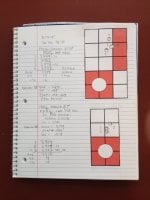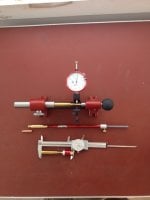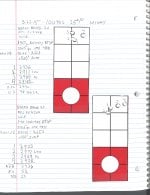My load development is finally all coming together for the .270 Win. Since I have had the rifle I have had inconsistent results - shooting a great group one day and then not so great the next day. Or, having a good group but also a flyer. Or, having consistent velocities one day and not consistent velocities the next.
Once, I had the chamber cast and realized how tight and short the throat was I made some adjustments and shot these groups on Friday. Two totally different loads using different bullets and different powders.

The adjustments included:
1. Utilizing a Hornady OAL guage to determine the where the bullet contacts the leade transition to the rifling.
2. Utilizing a Hornady Bullet Comparator to measure the ogive reading and set desired bullet jump.
3. Utilizing a Hornady Concentricity tool to correct loaded cartridge bullet concentricity.

I know this sounds like a Hornady advertisement but it is not intended to be. Any tools that perform the same functions would suffice.
I have found that the bullet comparators vary in size quite a bit. For example:
RCBS Precision Mic = .272"
Hornady # 27 Bushing = .267"
PTG Hex bullet comparator = .267"
I ended up using the Hornady #28 bushing (intended for the 7mm) since that has a diameter of .274" which seems to work well with my leade/throat dimensions.
I tested seven different .270 bullet types and due to the differences in point taper, every one had a different average ogive reading for contacting the barrel. Some bullets were extremely consistent (within .003" and others were less so (within .014".
For anyone just getting started in reloading, I don't think you could go wrong with the modest investment in the OAL gauge and any of the bullet comparators. The Hornady bullet comparator works very well the Hornady OAL gauge. For me, it is so much easier, faster, and more accurate than using the soot blackened method.
I found that I tend to get more consistent velocity measurements when the bullets are more concentric. Also, it seems that I get more consistent velocity reading with the 150 gr. BT than with the 150 gr. CTBST.
My main focus for deer hunting this fall will be with the 150 gr. BT. I just want to try a few different bullet seating depths to finalize the load.
The same is true with 140 AB and the Hornady 140 BTSP. Then I want to go back to the 150 gr. ABLR and try using what I know now.
When I run out of things to do I wil work with the 150 gr. PT and then the 140 gr. BT.
Once, I had the chamber cast and realized how tight and short the throat was I made some adjustments and shot these groups on Friday. Two totally different loads using different bullets and different powders.

The adjustments included:
1. Utilizing a Hornady OAL guage to determine the where the bullet contacts the leade transition to the rifling.
2. Utilizing a Hornady Bullet Comparator to measure the ogive reading and set desired bullet jump.
3. Utilizing a Hornady Concentricity tool to correct loaded cartridge bullet concentricity.

I know this sounds like a Hornady advertisement but it is not intended to be. Any tools that perform the same functions would suffice.
I have found that the bullet comparators vary in size quite a bit. For example:
RCBS Precision Mic = .272"
Hornady # 27 Bushing = .267"
PTG Hex bullet comparator = .267"
I ended up using the Hornady #28 bushing (intended for the 7mm) since that has a diameter of .274" which seems to work well with my leade/throat dimensions.
I tested seven different .270 bullet types and due to the differences in point taper, every one had a different average ogive reading for contacting the barrel. Some bullets were extremely consistent (within .003" and others were less so (within .014".
For anyone just getting started in reloading, I don't think you could go wrong with the modest investment in the OAL gauge and any of the bullet comparators. The Hornady bullet comparator works very well the Hornady OAL gauge. For me, it is so much easier, faster, and more accurate than using the soot blackened method.
I found that I tend to get more consistent velocity measurements when the bullets are more concentric. Also, it seems that I get more consistent velocity reading with the 150 gr. BT than with the 150 gr. CTBST.
My main focus for deer hunting this fall will be with the 150 gr. BT. I just want to try a few different bullet seating depths to finalize the load.
The same is true with 140 AB and the Hornady 140 BTSP. Then I want to go back to the 150 gr. ABLR and try using what I know now.
When I run out of things to do I wil work with the 150 gr. PT and then the 140 gr. BT.






